
Above from the table of contents to the Korean translation of Buying In.

Not sure when this came out, but I just got a copy in the mail today. There have been several translations, I think the only other one I have is the Chinese version, which I posted here. I did get an image of the Croation cover — posted here. I am a sucker for these, I think they’re really fun. Below, note the front-cover blurb from Salon.
I have to say, the Korean-language version, as an object, is pretty great. It’s well-done hardcover and even has one of those little bookmark ribbons. Classy!

Posted Under:
Buying In (the book)
This post was written by Rob Walker on September 27, 2010
Comments Off on It says, “Murketing.” (I assume.)
Q: I just wanted to recommend “Buying In” to someone, and I could not remember the full name, so I went to Amazon, and was surprised to find two full names, one with “The Secret Dialogue” and the other with “What We Buy”. Are these the same book or two different books? I want to make sure that I’m recommending the one I read.
A: Buying In: What We Buy prednisone and Who We Are is in fact the same book as Buying In: The Secret Dialogue Between What We Buy and Who We Are
is in fact the same book as Buying In: The Secret Dialogue Between What We Buy and Who We Are . The publisher thought it would be good to shorten the subtitle when the paperback version was published, because it would “allow for a less-cluttered and more powerful cover design.” Personally I thought the “secret dialogue” bit was the most interesting element of the title, but what do I know? Well, I know what I said when this was suggested: “okay.” It’s actually not all that unusual for books that are, shall we say, not best-sellers, to have their subtitles or even titles tweaked — Tyler Cowen’s last book came out in paper with a completely different title than the hardback version, to name a recent example. In any event, it is the same book; the only difference is that a few typos are corrected in the paperback version. If you recommend either, you should be fine.
. The publisher thought it would be good to shorten the subtitle when the paperback version was published, because it would “allow for a less-cluttered and more powerful cover design.” Personally I thought the “secret dialogue” bit was the most interesting element of the title, but what do I know? Well, I know what I said when this was suggested: “okay.” It’s actually not all that unusual for books that are, shall we say, not best-sellers, to have their subtitles or even titles tweaked — Tyler Cowen’s last book came out in paper with a completely different title than the hardback version, to name a recent example. In any event, it is the same book; the only difference is that a few typos are corrected in the paperback version. If you recommend either, you should be fine.
N.B.: Questions in “Ask Murketing,” basically a new feature, though I may have tried it earlier, are real and verbatim, and selected for inclusion from email I receive because I believe the answer may be relevant, or of interest, to (tramadol) others.
Posted Under:
Ask Murketing,
Buying In (the book)
This post was written by Rob Walker on August 16, 2010
Comments Off on Ask Murketing: What’s up with different subtitles on Buying In?
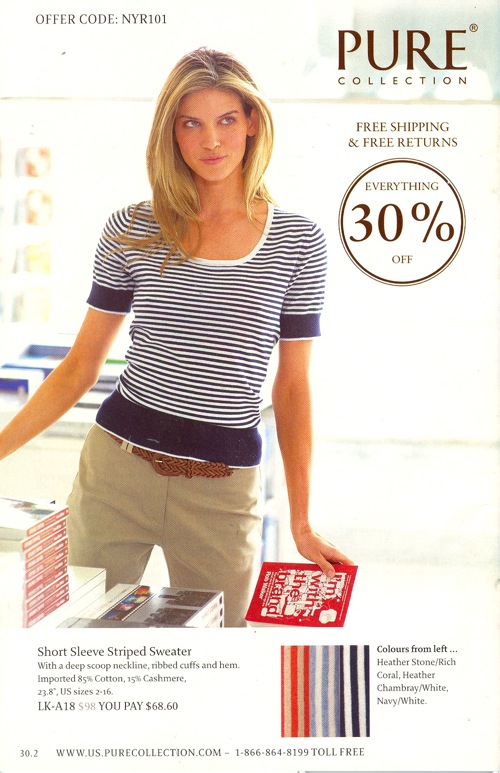
Ever wondered what my typical reader looks like?
Thanks to Jim Hanas for pointing out this ad for (the somewhat alarmingly named) Pure Collection, in which the model is clutching, of all things, a copy of the U.K. version of Buying In — which is titled I’m With The Brand over there, as mentioned earlier. I gather this is the back page of a catalog, and is apparently the only example in said catalog of a picture that includes a book (catalog use of books-as-props being something this series mentioned here, here and here.
I’ve vaguely pondered what it would mean if someone chose to product-place this particular book.
I’m still not sure.
Posted Under:
Buying In (the book)
This post was written by Rob Walker on June 14, 2010
Comments Off on My product has been placed

I got four copies of the “simplified Chinese” translation of Buying In today. Pretty cool, although I’m not sure what to do with four copies. Paging through, it was fun to look at the words and phrases (basically brand names and slang) that are I guess either untranslated or rendered in both languages for clarity.
Anyway it’s kind of a nice book, physically speaking.
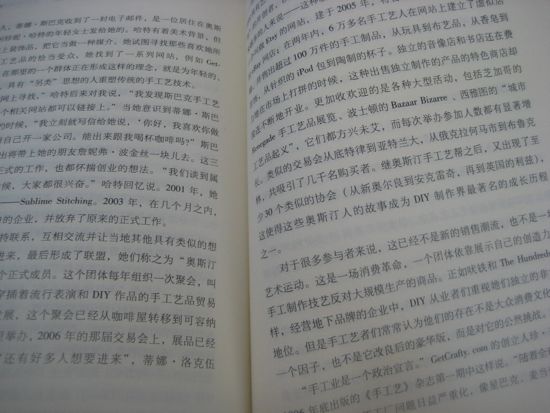
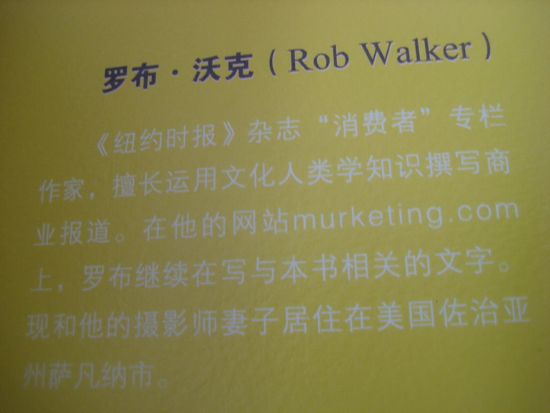
 Or maybe it was yesterday. Either way, Buying In: What We Buy and Who We Are
Or maybe it was yesterday. Either way, Buying In: What We Buy and Who We Are is now out in paper. It has a yellow cover. And a shorter subtitle. I made a couple of corrections of typos in the original book, but otherwise it’s the same, only cheaper. And with a yellow cover and… etc.
is now out in paper. It has a yellow cover. And a shorter subtitle. I made a couple of corrections of typos in the original book, but otherwise it’s the same, only cheaper. And with a yellow cover and… etc.
If you’re an educator who might want to assign the book, I might be able to get you a freebie to evaluate. Students seem to respond to it well, and I had great experiences doing Skype visits to classes in connection with the book last year. Contact is murketing@robwalker.net if you’re interested.
Here’s the book to look for:

Posted Under:
Buying In (the book)
This post was written by Rob Walker on September 23, 2009
Comments Off on Attn: Murketing readers in Croatia:
I mentioned this the other day. Somebody bought it! I don’t know who, and I’m not certain I’d want to know why. But maybe I would.
In any case, I was weirdly pleased to learn that it had sold.
BustedTypewriter is still selling other hollowed-out books to hold/hide devices or objects, here.
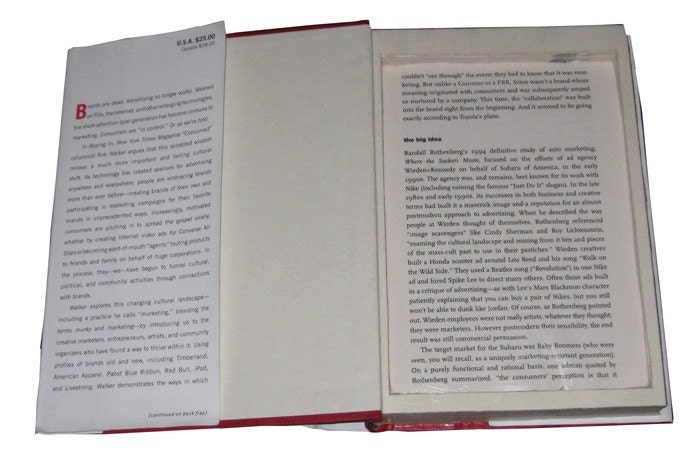
Available from BustedTypewriter on Etsy, for $25 — part of his Don’t Judge Me project.
This hardcover copy of “Buying In” by Rob Walker has been sealed and cut by hand to fit Amazon’s Kindle 6″ Wireless Reading Device.
More here. Thanks for the tip, BT. (I think.)
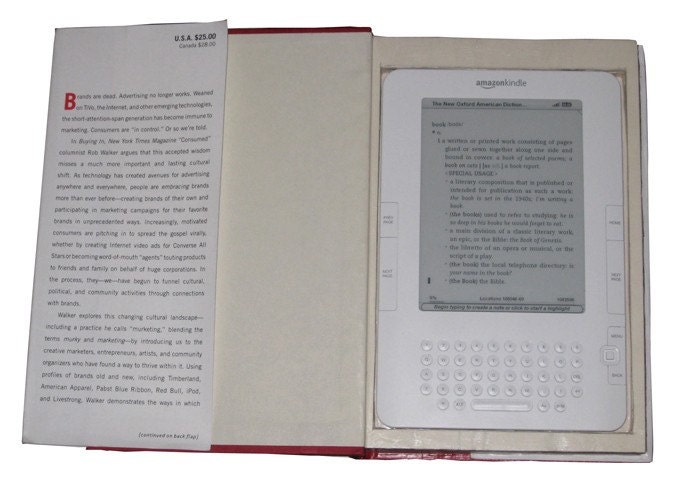
Save
[Below, a post I wrote and never actually published — but I just got another very similar note from a different Buying In reader on the same subject, so I am now going on the record with my views.]
 An interesting note from a Buying In reader came in the other day week. After some nice comments about the book in general (thanks again) my correspondent zeroed in on “a passing reference [in the book] that really surprised me: Coke’s monumental marketing flop with New Coke.”
An interesting note from a Buying In reader came in the other day week. After some nice comments about the book in general (thanks again) my correspondent zeroed in on “a passing reference [in the book] that really surprised me: Coke’s monumental marketing flop with New Coke.”
It’s true, I do make a passing reference to this, not for reasons that have anything whatsoever to do with my feelings about the Coke brand, but rather to make the point that pre-Web consumers were not the mindless, passive, drooling, couch-potato dupes that Web-era gurus insist they (we) were.
Anyway, my correspondent continued, explaining that “an acquaintance” in the sugar business had a different view, which is that the whole New Coke thing was really a backdoor way for the company to phase out sugar in favor of (cheaper) corn syrup in its flagship product:
They knew that their customers could tell the difference in a side-by-side taste test. So they launched New Coke, a formula they knew would flop, fully expecting to re-introduce Classic Coke after all the original formula Coke was off the shelves, with the sneaky little switch of sugar to corn syrup. My acquaintance at [redacted] said that sales to Coke plummeted at that time.
As I told my correspondent, I have read an awful lot about Coke and its rivals — whole books, many chapters, many many articles — and this was news to me. Also it sounded like an extraordinarily complicated, expensive, and risky way of changing an ingredient.
I turned to Snopes. While I hadn’t heard this rumor before, Snopes had. And in fact it turns out there are a number of theories suggesting that in way or another, the New Coke debacle was no debacle at all — the whole thing was essentially a hoax that served as a marketing stunt.
Snopes debunks all of it — including the corn syrup angle: Snopes says it’s true that Coke phased out sugar, but that this was completed, in the flagship formula, six months before New Coke arrived on the scene.
Snopes also gives the general context that’s consistent with everything I’ve ever read, which is that a) Coke was actually feeling — in fact actually was — pretty vulnerable at the time, and b) the taste-test research it did, concluding that consumers preferred the New Coke taste, was extremely extensive.
So, I am tending to go with Snopes on this. And I also stand by the actual point I was making in the book by citing New Coke, and the Edsel, and many other failures of the pre-Web era: Consumers have never been stupid, mindless dupes who simply do what advertising tells us to do. They (we) have always had the last say on whether a brand succeeds, or fails. Always.
But of course if you see things differently, I will not argue with you. I am just telling you what I think.
Jonah Lehrer, author of the celebrated How We Decide, describes an experiment suggesting a link between what something costs and how well we think it will work.
As it happens, the same experiment is described in the decidedly less-celebrated Buying In. But that’s not why I bring it up. I bring it up because an even more powerful demonstration of the same tendency was demonstrated in a more recent study involving the fictitious painkiller Veladone-Rx.
You might remember that if you’re a regular here, because that study was the inspiration for a 48-Hour T-Shirt. The T is no longer available, but the research description remains. It’s still one of my favorite studies ever (the upshot is that people found a placebo painkiller effective if it cost a lot — but not very effective if it was cheap).
For yet another discussion of how a higher price actually enhances consumer preception of utility, see this Murketing post about paying for garbage. (That post includes, though it is not quite about, a real-world example of prices and apparel that I think is harder to rebut than the ones Lehrer offers, but that’s just my bias.)
As noted: I’ll be speaking Friday night, May 8, as part of an event at New York University called Blowing Up The Brand: Critical Perspectives on Promotional Paradigms. This event is free and open to the public — but apparently because it’s at NYU you must register/RSVP, details here.
I’m working on my talk now, and it will be an attempt to tie together ideas about murketing-think as it relates to personal identity. I don’t meant personal identity in terms of “we are what we buy,” I mean the way the tools of commercial persuasion are being applied to the expression — or depiction — of indie-biz, of individuals, and of self itself. The blurring of the line, you might say, between commercial persuasion and personal identity.
Basically I will try to build on some of the ideas in Buying In: The Secret Dialogue Between What We Buy and Who We Are, as they are being manifested on a more personal level in this Web 2.0/Depression 2.0 moment.
I am thinking the talk will be titled, “If You Follow Me I Will Follow You Back.”
Needless to say, the book will be for sale at the event. So tell your friends, fans, and followers.
More about the conference here.
(I screwed up the dates of this event in the earlier post. What you see here is correct.)
[NOTE: I had the dates off by one day on this earlier; it is now correct.]
I guess that headline sort of says this already but, uh, I’m going to be in New York on May 7 as part of an event at New York University called Blowing Up The Brand: Critical Perspectives on Promotional Paradigms. You should come! Your friends should come! Especially if you and your friends are among the millions who haven’t yet found the right opportunity to purchase a copy of Buying In: The Secret Dialogue Between What We Buy and Who We Are. It’ll be for sale and if you buy one I’ll even sign it, if you go in for that sort of thing.
More on the conference momentarily, but I want to point out up front: It is free and open to the public — but apparently because it’s at NYU you must register/RSVP, details here. Space is limited and a chunk is reserved for NYU students and faculty, so if you’re interested, don’t sleep.
Okay so more about the conference:
Creative cities, PR nations, celebrity diplomacy, Hype Machine, branded philanthropy, YouTube identities….
These are both symptoms and effects of what Andrew Wernick termed “promotional culture”: the extension of promotional discourses, practices and performances into virtually all areas of public life.
What is at stake in these contemporary promotional paradigms?…
The goal of this two-day conference is to develop a set of productive critical perspectives on promotion in relation to contemporary culture. We seek to assemble creative and interdisciplinary frameworks to identify common themes and disjunctures inherent to these forms of communication. At issue is the changing role of the consumer-citizen-user in contemporary life.
Sounds interesting, eh?
So I’m doing a public talk/Q&A Friday night May 8. Then May 9 a variety of actual academics will present on a variety of topics around this theme. Check out all the details here.
Tell your friends, post it, Twitter about it, mention it to your Facebook contacts, and everything else. Thanks so much.
(By the way, I’ve added a new box to the column at left about “Places I Will Be.”)
Maybe more on SXSW later, but for the moment, this:
It’s Sunday at 5 pm and I’m sitting at the table at the SXSW “bookstore,” where I was signing books. After ten or fifteen minutes, the handful of (charming!) people who actually wanted me to sign a book, or who just wanted to say hello, have moved on.
I’m sharing the table with Christopher Schmitt, Cindy Li and Mark Tramme, authors of Professional CSS: Cascading Style Sheets for Web Design, and Markos Moulitsas Zuniga, of Daily Kos fame, who was signing Taking on the System: Rules for Radical Change in a Digital Era.
This is a lot of people at a small table, and we were pretty crammed in. There was actually a moment when it looked like the “bookstore” minders were going to have me stand, but I got a chair in the end.
Anyway, Markos’ signees had also moved on, so I chatted with him. Super-nice guy. The CSS book co-authors were also really nice.
So we’re all sitting there.
Then David Carson (who had been pointed out to me earlier) ambles over and picks up Buying In. (Carson is “perhaps the most influential graphic designer of the nineties,” per Wikipedia.)
He looks at it — front, back, flaps. He doesn’t look at me.
After about 45 seconds of examination, he puts the book down.
Then he walks away.
Oh well.
On Sunday March 15, I’m scheduled to be on a panel related to Gary Hustwit’s documentary Objectified, at SXSW in Austin. My understanding is that the panel is titled: “We Have Been Objectified: Identity, Consumerism, and the Future of Designed Objects.” Details are here.
Afterwards I’ll be signing Buying In at the “South By Bookstore.” Please stop by and say hello — and tell your SXSW-going friends who haven’t bought the book that now is the time. Details:
The South by Bookstore is located on the Trade Show Floor (#s 534, 535, 900), labeled South by Bookstore on the Trade Show map. Enter the Austin Convention Center (on 4th Street across from the Hilton), take the escalators up to the fourth floor, take a right when you get off the escalator and walk down the hall. The main entrance to the trade show is on your left. Walk to the back, right side of the room. The bookstore is along the back wall. There will be signs identifying it.
Rob Walker/Buying In: 5 – 5:30 pm, Sunday March 15
Posted Under:
Buying In (the book),
rw
This post was written by Rob Walker on March 1, 2009
Comments Off on SXSW “Objectified” panel and book-signing
 Back in November I made an offer to college and university classes to “visit” by way of Skype or similar means.
Back in November I made an offer to college and university classes to “visit” by way of Skype or similar means.
Those got underway last week with a great visit to Christine Harold‘s class at the University of Washington; it was a smart group and I had an excellent time.
The full semester schedule is below if you’re curious.
Feb 12: University of Washington (rhetoric and popular culture class)
Feb 18: Tufts University (media and society class)
March 3: Penn State book club (courtesy of Alex J. Mann)
March 23: University of Rochester (publishing class)
April 8: Sonoma State University (introduction to marketing class)
April 21: Boston College (communications and promotions class)




 "
"











 An interesting note from a Buying In reader came in the other
An interesting note from a Buying In reader came in the other 











 Kim Fellner's book
Kim Fellner's book  A
A